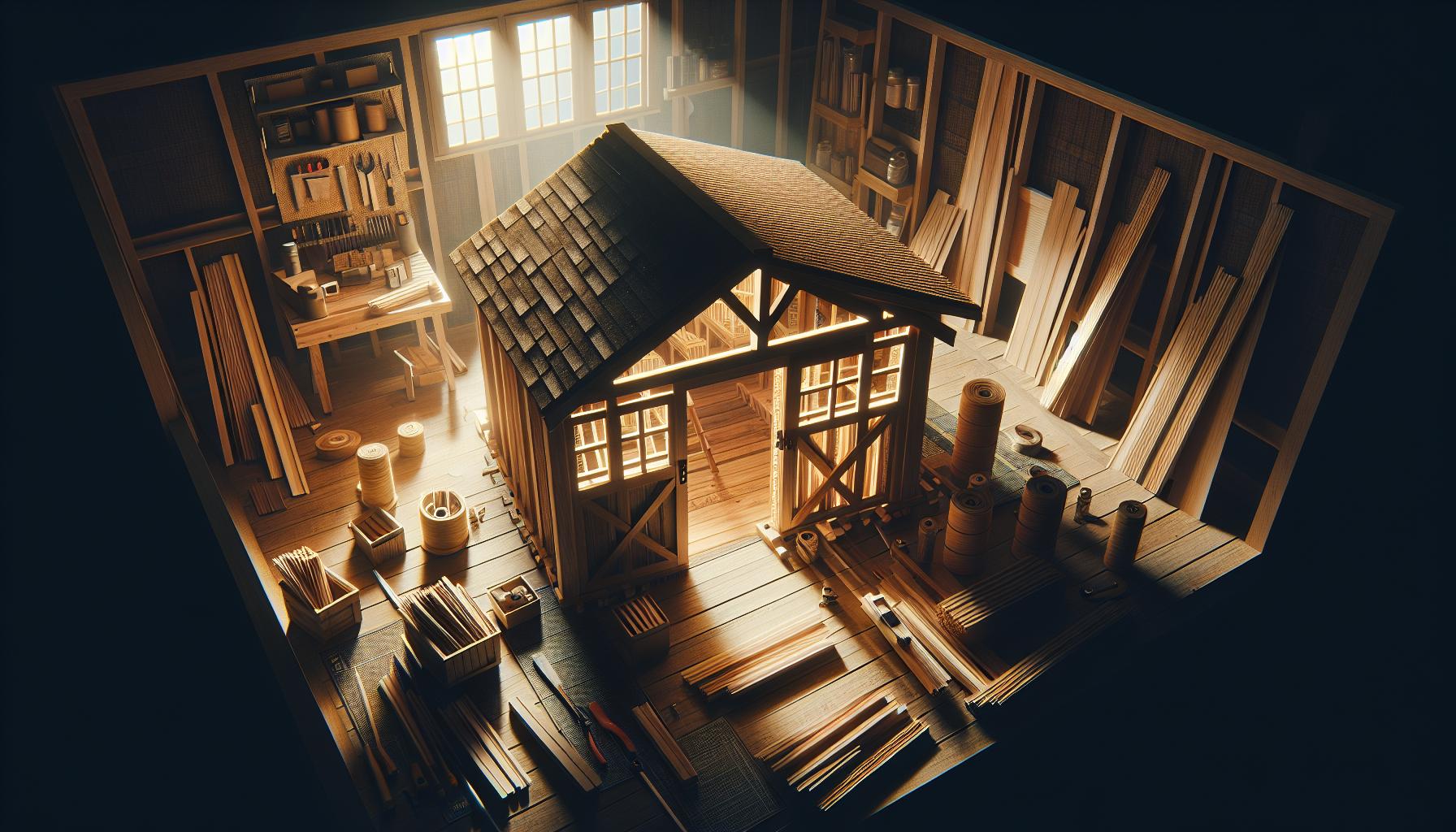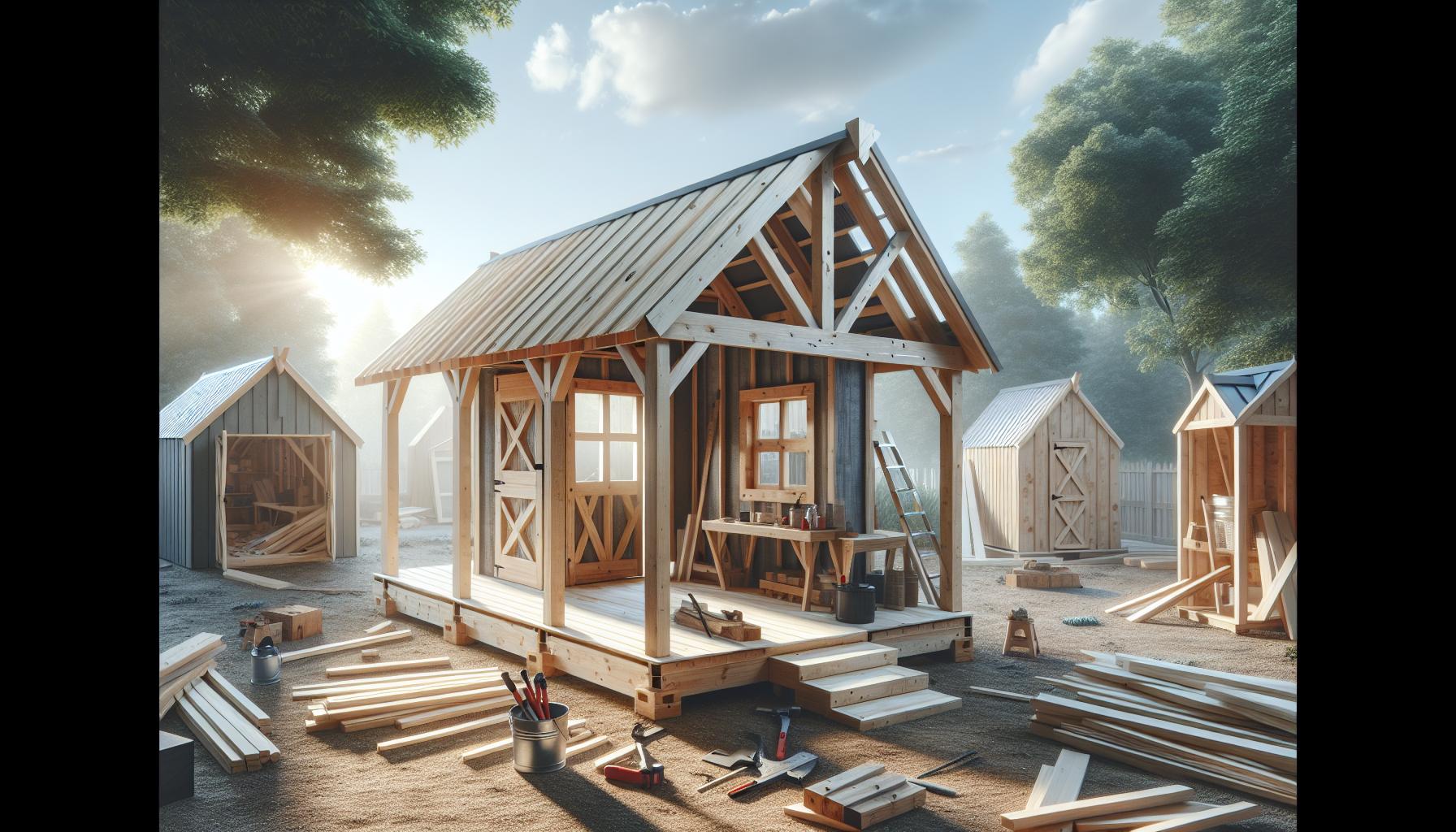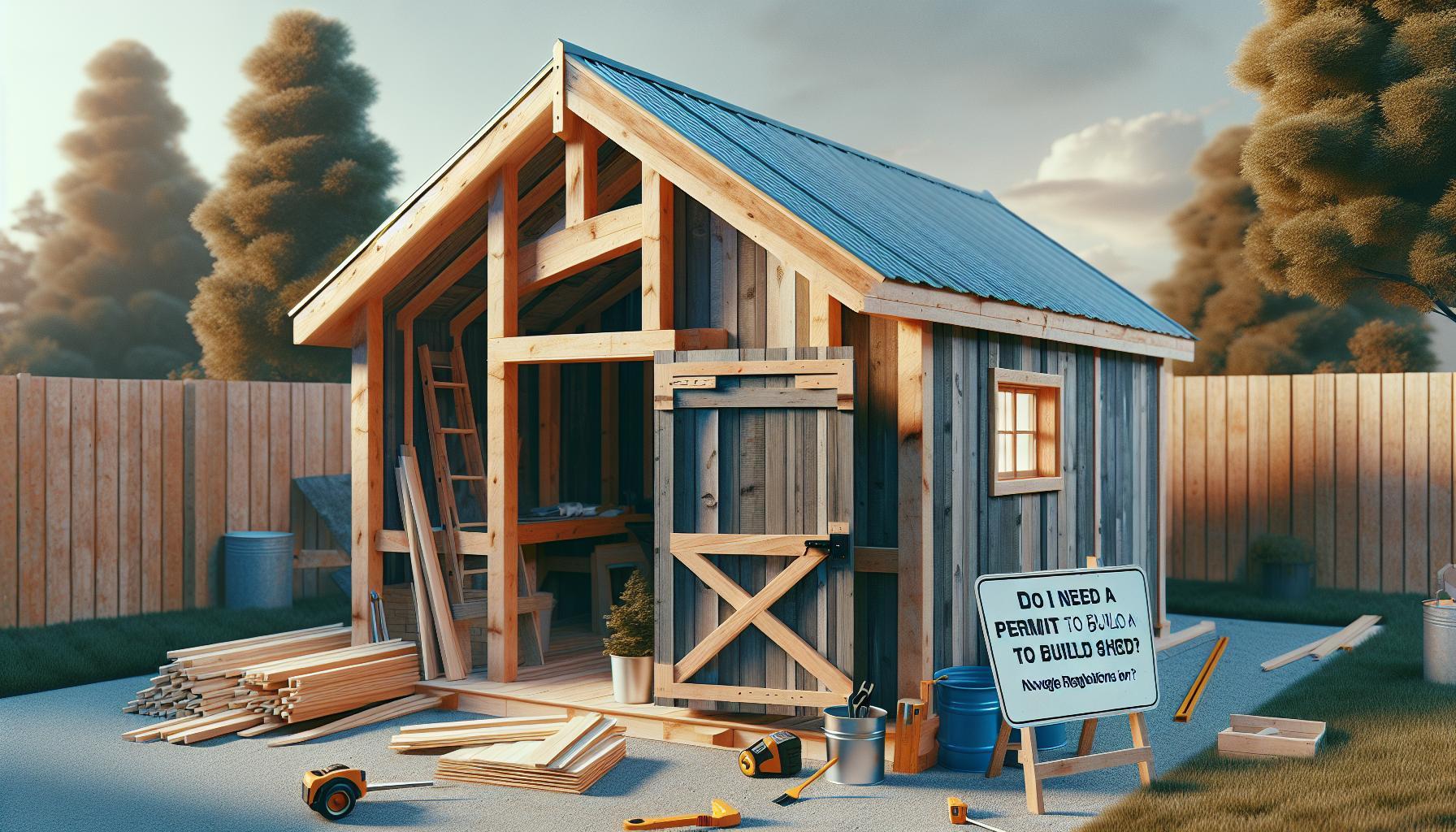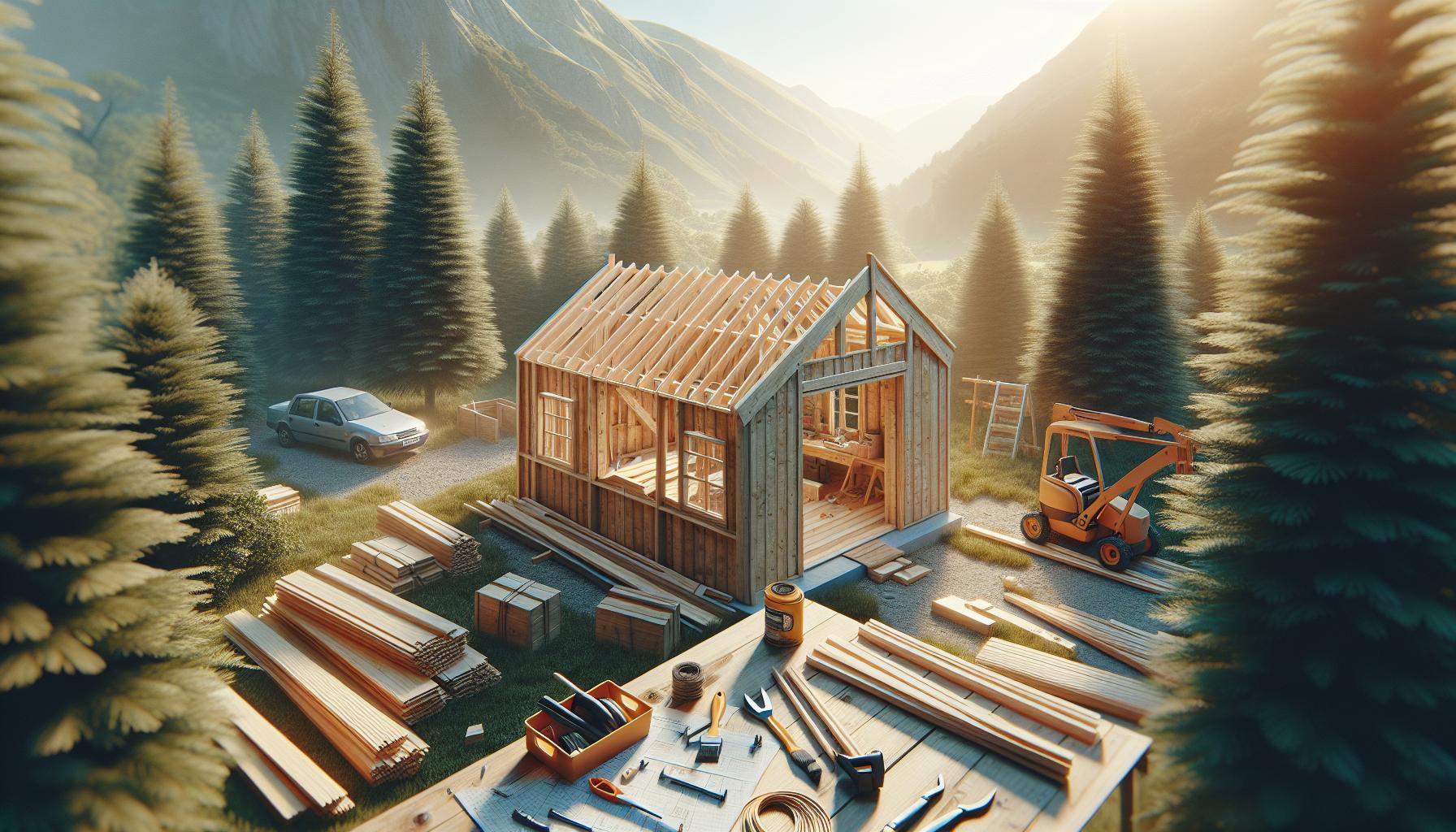Building a shed can enhance your outdoor space, but do you need a permit first? Understanding permit requirements is crucial to avoid costly fines or construction delays. this guide provides clear insights into the potential regulations surrounding shed construction,ensuring your project is compliant and hassle-free.
Understanding Building Permits: What You Need to Know for Your Shed Project
When embarking on a DIY project like building a shed, understanding the requirements for obtaining a building permit is crucial. Many homeowners underestimate the complexities involved, thinking that small structures like sheds may not require formal approval. However, the necessity for permits can vary significantly based on location, size, and intended use of the shed. Failing to secure the appropriate permits may lead to fines, forced removal of your shed, or complications when selling your home.
Why Building Permits Matter
Building permits are not merely bureaucratic hurdles; they serve crucial functions in ensuring safety and adherence to local zoning laws. Here are several key reasons to prioritize obtaining a permit for your shed project:
- Safety Standards: Permits guarantee that your structure meets safety codes and standards, protecting you, your family, and your property.
- Property Value: A permitted shed can enhance your property’s value, while an unpermitted structure may diminish it, leading potential buyers to be wary.
- insurance Coverage: Having a permit can make your insurance claims more straightforward in case of damage or disputes related to your shed.
Determining Permit Requirements
before starting your shed project, consult your local building department.They can provide data regarding regulations that apply in your area. Key factors that influence whether you need a building permit include:
- the shedS size: Many jurisdictions have size thresholds below which permits are not required.
- Your property’s zoning regulations: Specific zones may have restrictions on accessory structures.
- The intended use of the shed: Will it serve as a simple storage space, or will it house utilities or equipment? This distinction often affects permit requirements.
To help visualize the process, consider the following table summarizing common scenarios regarding building permits for sheds:
| Scenario | Permit Required? | Notes |
|---|---|---|
| Shed under 100 square feet | No | Check local laws as they may vary |
| shed over 100 square feet | Yes | Generally requires a permit |
| Permanent foundation | Yes | Usually requires detailed plans |
| Temporary shed for seasonal use | No | Verify local definitions of ‘temporary’ |
By leveraging the insights from this speedy assessment guide on shed building permits, you can navigate the process confidently. Always err on the side of caution: verifying whether you need a building permit is a proactive step that ensures your shed project goes smoothly from conception to completion.
Key Factors that Determine the Need for a Building Permit
Understanding the factors that necessitate a building permit is crucial for homeowners and builders alike, particularly when considering projects like sheds.Many individuals wrongly assume that small constructions, such as a shed, fall under the radar of permitting requirements. However, whether you need a permit often depends on several pivotal factors that can prevent legal complications down the road.
Size and Height of the structure
One of the most significant determinants of whether a building permit is required is the size of the proposed structure. Each jurisdiction has specific guidelines regarding dimensions. Generally,if your shed exceeds certain square footage limitations or height restrictions,a permit is mandatory. For instance, in many areas, sheds larger than 100 to 200 square feet may require a building permit. Always check local regulations to understand how size impacts your project.
Location and Setback requirements
The placement of your shed in relation to your property lines can also dictate the necessity for a permit. Most local zoning laws stipulate setback requirements that dictate how far structures must be from property boundaries.Failing to adhere to these regulations not only can lead to fines but might also necessitate the removal of your shed. Evaluating your lot’s dimensions against these rules is essential for a smooth construction process.
Type of Foundation
The choice of installation method significantly influences the permit process. Sheds that are constructed on a permanent foundation typically require permits, whereas those that are portable or temporary might not. If your shed requires a concrete slab or any form of extensive groundwork,be prepared to navigate the permit application process to ensure compliance with local building codes.
Local Regulations and Building Codes
Lastly, local regulations play a critical role in determining whether a permit is required for your shed.Building codes can vary not just from city to city but from one neighborhood to another. it’s advisable to contact your local building department or visit their website to familiarize yourself with the specific guidelines applicable to your project. Failure to secure a necessary permit can lead to significant delays and additional costs, including fines.
understanding the key factors—size, location, foundation type, and local regulations—is vital for anyone contemplating the construction of a shed. by adhering to these guidelines, you can avoid potential pitfalls associated with building permits and ensure your project is executed smoothly.
Navigating Local Regulations: Your Shed and Zoning Laws
Understanding local zoning regulations is crucial for anyone considering building a shed on their property.Not only do these regulations impact land use, but they can also determine what type of structures can be built, where they can be located, and how large they can be. Depending on your municipality, there may be specific zoning laws that govern the placement and dimensions of sheds, which means failing to comply could lead to fines or the need to remove your new building.When considering your shed project, start by checking the zoning classification of your property. Municipalities typically categorize land into various zones, such as residential, commercial, or agricultural, each with its own set of regulations that dictate permissible structures. In residential areas, as an example, local ordinances might impose restrictions on the size and height of a shed, and also how far it needs to be set back from property lines or other structures. Given that these rules can vary widely, a careful review of your local zoning laws is essential.
Steps to Navigate Zoning Laws for Your Shed:
- Visit your local government’s website or planning office to access zoning maps and codes.
- Contact your local zoning officer to clarify any regulations or permits required for your shed.
- Consider potential restrictions such as setbacks, height limits, and overall size requirements.
- If necessary, prepare and submit any zoning requests or building permit applications as part of the approval process.
Moreover, it can be beneficial to survey your neighbors’ sheds or outbuildings, as these structures can offer insight into what is commonly permitted in your area. For instance, if adjacent properties have similar structures without visible permits, you may glean that your community has more relaxed regulations than anticipated. However, always confirm through official channels before proceeding. Failure to adhere to local zoning laws not only jeopardizes your investment but could also result in your shed being labeled a nuisance or unsafe, further complicating your home betterment aspirations.
Ultimately, being informed about local zoning laws is a proactive means to ensure your shed project moves smoothly without unneeded interruptions. By taking the time to understand these regulations,you can proceed confidently with your building permit application—if required—and create the ideal space tailored for your needs. For more detailed guidance on this process, refer to the comprehensive ‘Do U Need a Building Permit for a Shed? Quick Assessment Guide,’ which explores the nuances further.
Common shed Building Scenarios That May Require a Permit
When considering a new shed for your backyard, it’s important to know that building permits may be necessary, depending on various factors. These regulations exist not only to ensure safety and adherence to local codes but also to maintain the aesthetics and functionality of neighborhoods. understanding the specific scenarios that typically prompt the need for a permit is crucial for anyone embarking on a shed-building project.
Common Scenarios Requiring a Permit
Several situations might necessitate obtaining a building permit before you start constructing your shed. Here are some of the most common scenarios to be mindful of:
- Large Structures: If your shed exceeds a certain size—often around 120 square feet in many areas—it typically requires a building permit. Always check your local regulations, as definitions of “large” can vary.
- Foundation Requirements: Sheds built on a concrete foundation or with a permanent structure are more likely to need a permit. Temporary or portable sheds may not have the same requirements.
- Utility Connections: If you plan to run electricity or plumbing to your shed, securing a permit is usually mandatory. This ensures that your installations meet safety standards and codes.
- Zoning Regulations: Local zoning laws may dictate where you can place a shed on your property. For example, if your shed is located within a certain distance from property lines or roads, it may require clearance and permits.
Considerations Before Building
Before commencing with your shed project, it’s advisable to conduct a thorough assessment in line with the guide on building permit requirements. Evaluate factors such as the intended use of the shed (agricultural, storage, or workspace), the materials you plan to use, and local building codes. Additionally,consulting with neighbors might be beneficial,especially if your plans could impact their view or access.
| Factor | Permit Required? |
|---|---|
| Size over 120 sq ft | Yes |
| Mounted on a permanent foundation | Yes |
| Electrical or plumbing work | Yes |
| Compliance with zoning laws | Yes |
| Portable or temporary structures | No |
By recognizing these common scenarios that may necessitate a building permit, you can avoid potential fines and ensure a smoother shed construction experience. Always remember to consult your local building authority to determine the precise requirements for your project, enhancing compliance and conscience construction.
Tips for a Smooth Permit Application Process
Crafting a smooth permit application process requires careful preparation and attention to detail, especially when it comes to building a shed. Many homeowners overlook the importance of understanding local regulations, but knowing whether you need a building permit can save you time and potential headaches down the road. It’s essential to be informed and organized as you navigate through this process.
- Research Local Regulations: Before applying, it’s crucial to check with your local zoning office or building department. Each jurisdiction has different rules regarding shed sizes, locations, and use cases. A quick call or visit can provide clarity on whether you need a permit and what the requirements are.
- Prepare Accurate Documentation: gather all necessary documents such as site plans or sketches of your proposed shed. include details like dimensions,materials you plan to use,and intended use of the shed. Providing this information upfront can expedite your application and prevent delays.
- Submit a Complete Application: Ensure that your application is filled out fully and correctly. Missing information can result in rejection or requests for additional details. Double-check everything before submission to streamline the approval process.
- Follow-Up: after submission,don’t hesitate to follow up with the permit office. Staying proactive shows your commitment to the project and can help you quickly address any issues that may arise during processing.
Understanding the Assessment Process
Being familiar with how your application will be assessed can significantly impact its success. Many jurisdictions evaluate applications based on compliance with safety standards, potential impact on neighboring properties, and adherence to local ordinances. Engaging with neighbors to inform them of your plans can also foster goodwill and mitigate concerns that might lead to objections.
| Key Factors to Consider | Description |
|---|---|
| Size of the Shed | Ensure that the proposed size is within limits set by local bylaws. |
| Setback Requirements | Check how far you need to position the shed from property lines. |
| Building Materials | Some materials may require special attention or approvals. |
| Utility Access | Assess if the shed will impact existing utilities. |
By paying attention to these tips and preparing thoroughly, you’ll be well on your way to securing the necessary permits. Understanding whether you need a building permit for a shed and navigating the application process doesn’t have to be daunting. Equip yourself with knowledge and take actionable steps to ensure success.
Essential Shed Specifications: Size, Height, and Placement Considerations
When planning to install a shed, one of the most crucial aspects to consider is its specifications. these include size, height, and placement, which can significantly affect not just functionality but also compliance with local building regulations. understanding these nuances can steer you clear of potential pitfalls, particularly when questioning, “Do U Need a Building Permit for a Shed? Quick Assessment Guide.”
Size Considerations
Choosing the right size for your shed is pivotal. Depending on your intended use—be it storage, a workshop, or even a hobby space—you’ll need to customize the dimensions accordingly. Here are a few factors to consider:
- Storage Needs: Assess what you plan to store inside. Larger tools or equipment may need a bigger space.
- Future expansion: Consider if you might need extra space later. It’s wise to build a shed that can accommodate future needs.
- Property Size: Ensure the shed’s size fits well within your property lines,avoiding encroachment on neighbors’ spaces.
Height Requirements
The height of your shed can impact both its functionality and regulatory requirements. Local regulations often dictate maximum heights for structures, which may vary based on zoning laws. Here’s what to examine:
- Usage: If you require overhead space for shelving or tall equipment,consider a shed with higher ceilings.
- Aesthetics: You want your shed to blend in with your existing landscape and home design.
- Neighbor Considerations: A towering shed might obstruct a neighbor’s view, leading to potential disputes.
Placement of your Shed
Finding the optimal location for your shed is equally critically important. The placement can affect visibility, accessibility, and adherence to local laws. Here are some key considerations:
- Property Lines: Check local regulations regarding how close you can build to property lines. This can prevent complications with permits.
- Drainage: Avoid placing your shed in areas prone to flooding. A well-drained location will prolong the life of your shed and its contents.
- Sun and Wind Exposure: Consider the sun’s trajectory and prevailing winds to ensure that your shed remains well-protected from the elements.
| Factor | importance | Example |
|---|---|---|
| Size | Must accommodate intended use | 10×12 ft for gardening tools |
| Height | Compliance with local regulations | Maximum 12 ft in residential areas |
| Placement | Affects utility and access | not within 5 ft of property line |
By considering these shed specifications—size, height, and placement—you can navigate the complexities of building regulations and avoid common misconceptions about permits. In your quest to answer, “Do U Need a Building Permit for a Shed? Quick Assessment Guide,” these factors will provide a practical foundation for your planning process.
When to Consult a Professional: experts Weigh In on Permit Requirements
Building projects can frequently enough be a mix of excitement and anxiety, especially when it comes to understanding permit requirements. The question of whether you need a building permit for your shed isn’t just about following the rules; it’s crucial for ensuring your structure is safe, compliant, and durable. Engaging a professional—whether it’s an architect, contractor, or local building authority—can significantly streamline the process and provide peace of mind.
Understanding Local Regulations
Regulations vary widely depending on your location,so consulting with a professional can help you navigate these waters efficiently. Local building codes typically dictate the size,placement,and construction materials permitted for sheds. As a notable example,in many areas,sheds under a certain square footage or height might not require a permit,while larger constructions will necessitate formal application processes. This is vital information that professionals can interpret in relation to your specific project.
Complex Situations
There are scenarios where seeking expert advice becomes even more critical. For example,if your shed will be installed near property lines,there may be setback requirements that you need to adhere to. A professional can help you assess the potential impact on your property and ensure compliance with any zoning laws. Additionally,if your project involves utilities or electrical work, professional input is essential to guarantee safety and code compliance.
Consultation Tips
When considering whether to consult a professional, keep these pointers in mind:
- Research qualifications: Check for local contractors or architects who specialize in residential projects.
- Ask about past experiences: Seek testimonials or examples of previous work related to shed installations.
- Verify permit knowledge: Ensure they are familiar with the specific permit processes in your area.
- Cost vs. risk assessment: Evaluate the potential risks of non-compliance against the cost of professional services.
Utilizing resources like the checklist from SF.gov can also help you understand which aspects of your shed project may need professional attention. Remember, while DIY projects can be gratifying, the complexities surrounding permits and regulations often warrant expert assistance to avoid costly mistakes down the line.
DIY Shed Builders: Best Practices for Compliance without Complication
Establishing a backyard shed can be a rewarding project, offering additional storage space or a tranquil workspace. However, navigating the maze of local regulations can feel daunting. Understanding whether you need a permit is crucial for ensuring your DIY project doesn’t run into compliance issues. The question “Do U Need a Building Permit for a Shed? Quick Assessment Guide” highlights common legal considerations, yet practical steps can simplify the journey into permitted territory.
Understand Local Regulations
Before you pick up your tools,familiarize yourself with your local zoning bylaws. This initial examination can save you time and hassle down the line. Many municipalities categorize sheds based on size and use, so knowing these parameters ensures you build within the legal framework. Here are the steps you should take:
- Check Size Restrictions: Many areas have a maximum size limit for sheds that can be built without a permit. Typical thresholds frequently enough range between 10 to 15 square meters.
- Determine Usage: Sheds intended for specific uses like housing animals or serving as living spaces may require stricter compliance.
- Consult Historical Rules: If your property is in a historical district, additional restrictions might apply.
Engage with Local Authorities
Once you’re clear on your own premises’ rules,establishing communication with your local building department should be your next move. Many municipalities host workshops or informational sessions about home improvement projects, where you could gain invaluable insights and guidance.You might find:
- permit Application Processes: Discover the specifics of how to apply for a permit if necessary, including estimated timelines and any associated fees.
- Pre-Application Consultations: Some places offer an opportunity to consult with a planner for informal advice before submitting formal documentation.
| Property Type | Typical Requirements |
|---|---|
| Residential | Size regulations, setback requirements, possibly a permit. |
| Commercial | Permit usually required, plus zoning compliance, fire code considerations. |
| Rural/Agricultural | Frequently enough fewer restrictions, but check local bylaws. |
Being proactive can save you from unexpected complications. For instance, consider the story of a homeowner who built a charming rustic shed only to discover it breached local height restrictions. By consulting early, she learned that a pitch-adjustable roof could have easily accommodated both her vision and the regulations. Such examples underscore the importance of research and communication before hammering in the first nail.By focusing on compliance without complication, you can realize your shed-building dreams successfully and legally.
Frequently Asked Questions
Do U Need a Building Permit for a Shed?
Yes,in most cases,you do need a building permit for a shed. Regulations vary widely depending on your location. it’s crucial to check with your local building department to understand specific requirements.
Many municipalities require permits to ensure safety and compliance with zoning laws. Even small sheds can fall under these regulations. Additionally, understanding local building codes helps avoid potential fines or issues during future property transactions.
How to Determine If You Need a Permit for a Shed?
To determine if you need a permit, first consult your local building authority’s website or office. Typically, they’ll provide guidelines based on the size and location of your shed.
For instance, sheds larger than 100 square feet often require a permit. Other factors like setback regulations and proximity to property lines also influence the need for a permit. Always check local ordinances before starting your project.
What Is the Typical Size for a Shed That Requires a Permit?
The size that necessitates a permit varies, but generally, sheds over 100 square feet require one. Sizes below this threshold frequently enough fall under exemption rules.
However, requirements can differ significantly from one locality to another, making it essential to confirm with your local regulations.Even if your shed is small, other factors may still make a permit necessary.
Can I Build a Shed Without a Permit?
Technically, you can build a shed without a permit if it meets specific size and location criteria. However,this depends on your local building codes.
Neglecting to check regulations can lead to costly fines or the need to remove the shed entirely if it violates codes. It’s wise to ensure compliance upfront to enjoy eace of mind during your project.
Why Does a Shed Require a Building Permit?
A building permit ensures your shed complies with safety standards, zoning laws, and building codes. It safeguards structural integrity and addresses any potential environmental concerns.
Permits also facilitate proper inspections, which help prevent issues such as water damage or foundation problems later. Understanding these aspects is vital, especially for DIY shed builders looking to maintain high-quality craftsmanship.
What Happens if I Build a Shed Without a Permit?
If you build a shed without a permit, you may face fines, forced removal, or retroactive permits. Local authorities monitor construction projects, so noncompliance can lead to serious consequences.
Even if you’re tempted to skip this step, frequently educating yourself on local compliance can save you from future hassle.For more on compliance, check out our article on local building regulations.
How Long Does it Take to Get a Building Permit for a Shed?
The time to acquire a building permit can vary, typically ranging from a few days to several weeks, depending on your location and the complexity of the project.
Factors such as local workload and permit requirements affect the timeline. To expedite the process, ensure that your application is complete and meets zoning criteria from the start. This can significantly reduce delays.
Wrapping Up
navigating the requirements for building a shed can feel daunting, but with the right knowledge, it becomes a manageable task. Remember, understanding the necessity of a building permit is essential to ensure compliance with local regulations and avoid potential headaches down the road. By taking a few moments to assess your specific situation—such as the size of your shed, its intended use, and your local zoning laws—you can confidently move forward with your project.
As you embark on this DIY journey, keep in mind the importance of quality craftsmanship and thoughtful planning. Don’t hesitate to reach out to local authorities for guidance; they can provide clarity and help you avoid common pitfalls. with every step you take, from drawing up your plans to the final installation, you’re not just building a shed, but a space that enhances your property and fulfills your needs.
We encourage you to explore our resources further and dive into the intricacies of shed construction. Whether you’re a seasoned DIYer or just starting out, there are tools and tips available to help you achieve the perfect result. Embrace the challenge and enjoy the journey—your dream shed awaits!








